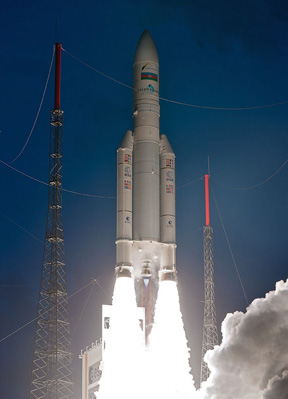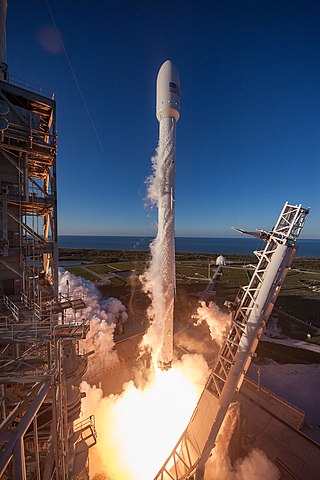
Intelsat S.A. is a multinational satellite services provider with corporate headquarters in Luxembourg and administrative headquarters in Tysons Corner, Virginia, United States. Originally formed as International Telecommunications Satellite Organization, from 1964 to 2001, it was an intergovernmental consortium owning and managing a constellation of communications satellites providing international telecommunications and broadcast services.
Myanmar has begun the liberalization of its Telecommunication market in 2013.

A communications satellite is an artificial satellite that relays and amplifies radio telecommunication signals via a transponder; it creates a communication channel between a source transmitter and a receiver at different locations on Earth. Communications satellites are used for television, telephone, radio, internet, and military applications. Many communications satellites are in geostationary orbit 22,300 miles (35,900 km) above the equator, so that the satellite appears stationary at the same point in the sky; therefore the satellite dish antennas of ground stations can be aimed permanently at that spot and do not have to move to track the satellite. Others form satellite constellations in low Earth orbit, where antennas on the ground have to follow the position of the satellites and switch between satellites frequently.

The Indian National Satellite System or INSAT, is a series of multipurpose geostationary satellites launched by ISRO to satisfy the telecommunications, broadcasting, meteorology, and search and rescue operations. Commissioned in 1983, INSAT is the largest domestic communication system in the Indo-Pacific Region. It is a joint venture of the Department of Space, Department of Telecommunications, India Meteorological Department, All India Radio and Doordarshan. The overall coordination and management of INSAT system rests with the Secretary-level INSAT Coordination Committee.

A ground station, Earth station, or Earth terminal is a terrestrial radio station designed for extraplanetary telecommunication with spacecraft, or reception of radio waves from astronomical radio sources. Ground stations may be located either on the surface of the Earth, or in its atmosphere. Earth stations communicate with spacecraft by transmitting and receiving radio waves in the super high frequency (SHF) or extremely high frequency (EHF) bands. When a ground station successfully transmits radio waves to a spacecraft, it establishes a telecommunications link. A principal telecommunications device of the ground station is the parabolic antenna.

SES S.A. is a Luxembourgish satellite telecommunications network provider supplying video and data connectivity worldwide to broadcasters, content and internet service providers, mobile and fixed network operators, governments and institutions.
TONGASAT is the licensed agent of the Kingdom of Tonga responsible for making and coordinating Tonga's satellite filings to the International Telecommunication Union and then licensing those satellite filings to international satellite operators for their commercial use, in effect a flag of convenience for space. Tonga was the sixth-largest claimant of orbital slots due to Tongasat's efforts. In 2002, Tongasat launched the Esiafi 1 satellite; as of 2015, a satellite in its spot was still in operation.
Spacecom, or Space Communication, is an Israeli communications satellite operator in the Middle East, European Union and North America headquartered in the city of Ramat Gan, Israel. Spacecom operates two satellites at orbital position 4° West – AMOS-3 and AMOS-7, one satellite at orbital position 65° East – AMOS-4, and one satellite at orbital position 17° East – AMOS-5.

The Intersputnik International Organization of Space Communications, commonly known as Intersputnik, is an international satellite communications services organization founded on 15 November 1971, in Moscow by the Soviet Union along with a group of eight formerly socialist states.
Astra 31.5°E is the name for the group of Astra communications satellites co-located at the 31.5° east position in the Clarke Belt owned and operated by SES based in Betzdorf, Luxembourg. 31.5° east is SES' newest orbital location serving Europe.
Astra 5A was one of the Astra communications satellites owned and operated by SES at the Astra 31.5°E. Launched in 1997 to the 5° East position by NSAB as Sirius 2, operation of the satellite was transferred to SES in April 2008 and the craft renamed and moved to 31.5° East to open up a new orbital position for the company for the development of markets in Eastern Europe and the Middle East.

Azerspace-1/Africasat-1a', is Azerbaijan's first satellite in space. Built by Orbital Sciences Corporation, it was launched by Ariane 5 into orbit on February 7, 2013 from Kourou in French Guiana at orbital positions 46° east. The satellite covers Europe and a significant part of Asia and Africa. It is operated by the Azerbaijani company Azercosmos and has transmission capabilities for TV, radio broadcasting and the internet.
Azerbaijan National Aerospace Agency is a governmental body that coordinates all Azerbaijani space research programs with scientific and commercial goals. National Aerospace Agency has been operating as a "Kaspiy" Scientific Center within the National Academy of Sciences of Azerbaijan since 1974 and the Space Exploration Scientific Production Association (CTEB) was established based on "Kaspiy" Scientific Center in 1981. Azerbaijan National Aerospace Agency was established in 1992 by the Decree No. 580 of Azerbaijani President in place of the Kaspiy scientific research center of the National Academy of Sciences of Azerbaijan.

The Ministry of Digital Development and Transportation is a central executive body implementing state policy and regulation in the areas of transport, including maritime transport and civil aviation, communications, high technologies.
Satellite television varies in the different regions around the world.
Galaxy 25 (G-25) launched in 1997, the launch was contracted by International Launch Services (ILS), is a medium-powered communications satellite formerly in a geostationary orbit at 97° West, above a point in the Pacific Ocean several hundred miles west of the Galapagos Islands. It was manufactured by Space Systems/Loral, part of its LS-1300 satellite bus, and is currently owned and operated by Intelsat. The satellite's main C-band transponder cluster covers the United States, Canada, and Mexico; its main Ku-band transponder cluster covers the United States, Mexico, and the Northern Caribbean Sea. An additional C-band and a Ku-band transponder pair targets Hawaii.

Intelsat 901 (IS-901) was the first of nine new Intelsat satellites launched in June 2001 at 18° West, providing Ku-band spot beam coverage for Europe and C-band coverage for the Atlantic Ocean region. It is capable of selectable split uplink for Satellite news gathering (SNG), tailored for increased communications demands such as DTH and Internet.

Space Agency of the Republic of Azerbaijan (Azercosmos) (Azerbaijani: Azərkosmos Açıq Səhmdar Cəmiyyəti (Azərkosmos ASC)) is a public legal entity under Ministry of Transport, Communications and High Technologies of the Republic of Azerbaijan and successor of Azercosmos Open Joint Stock Company, the first satellite operator in the Caucasus region entirely owned by the Government of Azerbaijan. With the telecommunication satellite Azerspace-1, the company provides broadband and broadcast services to customers in Europe, Africa, the Middle East, the Caucasus, and Central Asia. With the Earth Observation satellite Azersky, Azercosmos provides satellite imagery and geoinformation services.

Intelsat 35e, also known as IS-35e is an Intelsat high-throughput (HTS) geostationary communications satellite designed and manufactured by Boeing Satellite Systems on the Boeing-702MP satellite bus. It was launched on 5 July 2017.
Azersky is an Earth observation satellite with a high-resolution of 1.5 m. It is Azerbaijan's first Earth observation satellite. It was launched into orbit in June 2014.










